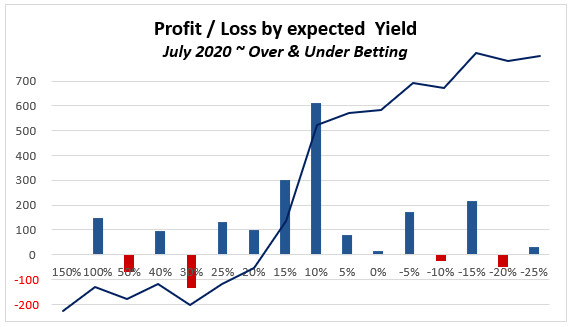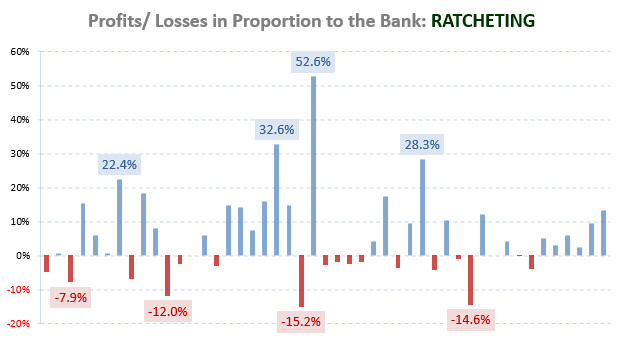
In conjunction with our regular match previews published in the German Betfair blog we are pleased to present our league match with head-to-head history ‘Value’ bet detector spreadsheet.

with H2H History
WITH Asian Handicap
(ex VAT; see below)

WITHOUT Asian Handicap
(ex VAT; see below)

0% VAT to UK customers
0% VAT to Non-EU customers
Read more: EU VAT Legislation
e-shop: Product Overview
View Your Shopping Cart
Our bet selections are always based on true odds calculations identifying mathematical ‘value’ in the markets. Of course, not every bet can win, but ‘value’ betting is the only reliable method of ensuring long-term betting profits.
‘VALUE’ bet detector: The Excel spreadsheet calculates the ‘true’ odds (= expected probabilities based on historical statistics) and then displays each ‘value’ bet recommendation. For every event included the expected values are calculated, compared to market prices, and finally the statistical probability of winning the bet is shown.
Soccerwidow follows the philosophy that only through identifying bets containing mathematical ‘value’ in the prices offered by bookmakers or exchanges is it possible to make consistent profits.
It should be noted that the spreadsheet is not a tool for automated betting. The tables provide vital information to improve the accuracy of your own predictions, and the figures do not substitute for reading salient news and applying good judgement.
The Excel spreadsheet offered for sale comes pre-filled with data from the Premier League game Liverpool v. Manchester City on 26/8/2012. Just delete or over-type this to analyse any match of your choosing.
Read a few sample match previews which apply ‘League Games with H2H History’ calculations:
- 26.8.2012 English Premier League: Liverpool v. Manchester City – Statistical Match Analysis & Football Betting Predictions
- 6.8.2012 Norwegian Tippeligaen: Stabæk v. SK Brann – Statistical Match Analysis & Football Betting Predictions
- 5.8.2012 Belgian Jupiler League: Zulte-Waregem v. Gent – Statistical Match Analysis & Football Betting Predictions
Notes: Adjust the picture quality at the bottom of the screen above by clicking on the ⚙ button (to the left of the YouTube logo), then click on ‘Quality’ and choose a higher resolution as desired. Go to full screen mode by clicking on the box symbol (to the right of the YouTube logo).
Supporting Videos
Data Sourcing: Learn where to find historical match data and download it from www.football-data.co.uk to make your own Excel store of statistics.
Data Input: Historical match results and head-to-head data input to populate the Value Bet Detector ready for input of the best odds you can find.
Frequently asked questions:
Can I use the spreadsheet in other leagues?
Yes, the calculations apply for any league in the world. The only parameters are that the game in question must be between two teams which have played at least their last 25 home or away games in the same league. The calculations are based on the home team’s last 25 home games and the away team’s last 25 away games, in the same league. Also, both teams must have played the corresponding fixture at least 6 times in the last 10 years (in other words, the home team has hosted the away team at least 6 times in all competitions (not friendlies) in the last 10 years).
How long does it take to enter historical data into the spreadsheet?
This is a manual procedure and you will quickly find which sources are best for the full-time and half-time results of both teams in the 25 matches to be analysed, plus the head-to-head encounters. We recommend Football-Data, Betexplorer, Oddsportal and Soccerway, although there are a host of other sites specialising in historical statistics.
At the start, you will find data collection will take about 30 minutes per match including entering the best bookmaker odds you can find (try Betfair and Oddschecker).
Are the formulas for the spreadsheet calculations visible?
Yes, we have hidden none of the formulas.
Exactly which historical records do I have to input?
The full-time and half-time scores for both team’s last 25 matches (home games only for the home team, away games only for the away team), plus the same for the head-to-head encounters over the last 10 years.
What knowledge is required?
You should already have a understanding of odds and how they are calculated. The spreadsheet is just a tool to identify potential bet candidates. You will need to understand what is meant by the term ‘value’ and also have a good idea how to spread risk with a well-structured betting portfolio. The spreadsheet is intermediate level, and you should be become entirely familiar with its mechanics before committing money to any bet recommendations suggested by the spreadsheet.










Hello. I have been using the value calculator for a while. Started with only the Bundesliga and then went on to Premier League, Serie A, Spanish Liga 1, French Ligue 1 and Belgium. The results were very good at first but for some time I have been seeing that Serie A games and Premier League games have produced a pretty significant loss.
I really do not have a significant number of games, only about 40 or 50 in each league. I was wondering if there are leagues that you would advise to avoid and if there are some leagues that can fit better with this method.
I’m using the valucalculator method for league games. I know that when the league relative standard deviation for that bet type is smaller than yield its a clean valuebet. But I’d like to know how do I identify the bets that are good for laying with VC. Is it that simple that if it’s not a valuebet then it’s a good lay canditate?
Hi,
Can I have the password to unlock the sheet?
Thanks!
What you say makes a lot of sense. Particularly the part about comparing apples with apples. I’m going to carry on testing the value calculator against random matches and studying up with the Fundamentals of Sports Betting.
Then, depending how quickly I get my head around that, I’ll move on to the various HDAFU tables and actual betting.
I seem to recall one of the guys who regularly comments mentioning using the value calculator as the first requirement for value testing. Then he added some other requirement (perhaps some slight alternation he had made with the spreadsheet?) and when both tests implied value, he would proceed. I’ll look back through the the comments section to try to find out exactly what he did and how how. It may be superfluous but it’s food for thought.
I also have to say this has gotten me more interested in maths again. I wasn’t naturally brilliant at it at school. But I was good as long as I did lots of homework. That is, until Year 11 (then I got too bogged down by the workload of other subjects and fell behind). But this has given me a newfound interest in Calculus and probability. The more exact nature of the answer is somewhat reassuring. You can get that with maths, at least.
Kind regards.
Hey guys,
I’m just testing out the value calculator. I’m looking at Ligue 2 in France.
The trouble is that I can’t find the half-time scorelines from the 2009/10 season. They don’t have them on either betexplorer.com or soccerbase.com as far as I can tell.
Any advice? How do you normally deal with bets on Ligue 2?
Hi Audiendi, you can also try oddsportal.com. However, if you don’t find the stats then I would recommend just leave the half-time bets alone.
How we normally deal with bets on Ligue 2? We normally don’t bet; easy as that. 🙂 No time! And I personally, no real interest. I feel much more intrigued by the maths and being able to predict the outcomes than the betting itself. You simply cannot imagine how time-consuming it is to run this website (and there is even a German sister site); write course books and do all the research which goes with it. It was only the HDA tables, my husband tried for a couple of seasons to prove to ourselves that they work.
Another thing is that there are sooooooooooo many different leagues in this world, and each of them having something special about them that we simply cannot know an answer to everything.
Hello,
I gave the spreadsheet a try on the Manchester City – Liverpool fixture (Sept 9, 2017). I filled the home, away and h2h data in, also the Odds my bookmaker offered.
I then looked to what the automatic back/lay recommendations were. As I cannot access a betting exchange, I can’t lay bets so I only look for “back” recommendations. Generally, this would appear for when the true odds are lower than the bookmaker odds.
But….
– there is no back recommendation in column S. This column is for automatic recommendations. However, for a DNB bet on Liverpool, true odds are 2.38 while bookmaker odds are 3.15. Thus, I expect a positive value. Nothing shows up automatically so I type “Back” in cell R12. Now Value II gives 32.4%, which sounds really nice to me. But when I have to type “Back” manually in column R because nothing shows up automatically in column S, even for a nice 32.4% value bet, this kinda defeats the purpose of this automatically value detector..
– there are only “B” spotted in column Q for under 4.5, under 5.5 and under 6.5.. I don’t find it worth betting on odds 1.09 (under 5.5), but when I type “Back” in column R, just to get a “Back” in column S, the bookmaker probability in column U shows 8.3% .. 1/1.09 however is 91.7%. So the probability is for backing over 5.5??
– For this certain bet (under 5.5, when I type “Back” in column R), the Value II in column X is negative (??), even though the bookmaker odds are higher than the true odds.
These are just a few of my questions, but I guess that will do for now.
Do you want me to email you a copy of the filled in spreadsheet for ManCity-Liverpool?
Kind regards
Hi Bert,
the automatic bet recommendations formulas check various conditions that produce more reliable bets (within the expected cluster) than others. For example, you write that the DNB bet on Liverpool had true odds of 2.38 and the bookmaker odds were 3.15. You are right, on the first glance there seem to be a positive value of 32.4%, but this is so far out of the range of expected odds (taking deviation into consideration) that there is something in this match what bookmakers know and the formulaic approach doesn’t factor in. Bets who are deviating too much from the expectations produce long-term losses; that is why the VC doesn’t flag them up.
For the Over/Under bets you need to type for example “Back U 5.5” or “Back O 5.5” and so on; then something will show up.
The ‘Q’ column uses other criteria than the ‘S’ column to flag up bets. Therefore you will see sometimes bet recommendations flagged up in both columns, sometimes only in one. If both flag up, these are bets who will be probably more reliable than others.
What you must not forget is that whatever flags up there are never 100% sure bet recommendations. However, what flags up will be producing a close match to the expected distribution. For example, if a bet flag up with ‘L’ in the ‘Q’ column and ‘Lay’ in the ‘S’ column then please keep in mind that this isn’t going to be a 100% secure lay but carrying out many bets of this type you will come pretty close to the expected ‘hit rate’. Say in this example, the expected hit rate were 78% then you should see a hit rate of approx. 8 out of 10 bets winning.
Do you know my course Fundamentals of Sports Betting? This may be a product you may consider of purchasing as it explains bookmaker maths in great depth and detail. You may find the course very helpful! 🙂
I can completely understand that under the circumstances you were not able to do the things you planned. However, if you do update the spreadsheet, will customers who purchased the former spreadsheet get the new version? (Just a question)
Hi Bert, if we ever update the spreadsheet then of course, yes, customers who bought the old version will get a huge discount on the new version.
For example, as we published the updated version of the course, buyers of the 1st edition paid 49£ less (this was the price for the 1st edition).
However, it will take probably another year before we get to an update of the current VC as the current version works just fine for everybody who gets their head round it.
By the way, I explained the use of the VC in length in the course for its use on Over/Under bets. You may consider purchasing the course together with the VC.
Hello Soccerwidow,
At 7 July 2013, you wrote that there is an update of the spreadsheet on the way which would identify even more accurate picks. I’m interested in buying the spreadsheet, but would like to buy the latest/best/most accurate version. The first replies on this topic were at early October 2012. Since there has been almost 5 years in between, I just wanted to make sure the version in the article is the most upgraded version. Or should I look for this upgraded version in another article?
Kind regards
Hi Bert, since the 7 July 2013 happened a lot, and the most devastating event was that I’ve had a severe accident in this year. It took me more than two years to recover and therefore many things which were originally planned haven’t been addressed.
It was October 2015 that I finally succeeded to review the Over/Under course in German and then to translate the course into English which was then published in June 2016.
Therefore, sorry, there isn’t an update of the Value Calculator and unfortunately, there won’t be for a while as I’m currently writing on a 1×2 course.
One thing at the time, Rome also hasn’t been built in one day. 🙂
Hi Soccerwidow
I purchased the value calculator back in summer 2013 but I’ve just lost all files on my computer!
Can you see if you still have a record of my purchase (I know, a long shot) and if so, can you arrange to resend?
My email address should be the same at the time of purchase if that helps.
Thank you
Hello Jonathan,
I have just emailed you in more detail, but for the sake of everyone else, we charge a fee of £10 to retrieve old products that have gone beyond their 30-day download limit.
This is purely because it is a time-consuming exercise to find the original sale in our online store or manual records and then reactivate the product (which may even be defunct by now).
A message to everyone – please back-up your purchases! We can save you if you do lose them, but it will cost you a fee for our time! 🙂
Hi again Right Winger,
Thanks again for your reply and support. I’m persevering with the VBC, mixed results but I’m starting to record my results better with cluster groups so I’ll have a better idea of my progress eventually.
I’ve been once again checking the helpful comments above to ensure I don’t re-ask a previous question, but just to confirm:
1. When including results for the league history, you recommend excluding any type of play off game? Does this include relegation games? Then with the H2H history anything other than Club Friendlies?
2. I’m just curious as to what sentinel checks yourself or the Soccer Widow would undergo before placing a bet? I know this is something you encourage us to work out ourselves, but to help formulate my own approach I am curious as to your approach? Do you guys solely go by the VBC calculations, or do you have a quick glance at recent form, injuries, weather, etc?
3. Is there any value in your opinion in using other VBC calculations to support a market you might be interested in placing a bet on, eg favouring an under 2.5 market’s value and looking to the fulltime score calculations to support this decision’s probable outcome?
4. Are there any markets that you wouldn’t mix as a general rule, I know this is obvious in some cases, but I was just after you opinion.
I understand, appreciate and commend you guys on instilling us with the confidence to come up with our own system and that you don’t give out ‘betting advice’. So if any questions I’ve posted cross that line I completely understand, I’m just after ideas to help formulate my own personal approach.
I am determined to make the VBC work for me and have faith it will pay off long term and I believe the more I investigate and tweak, the greater my success will be. Sorry to say that this may potentially mean harassing you more 😉
Many thanks.
Hi Sam,
the VC is for League Games with H2H history and as the names implies for ‘league games’ only. Therefore do not include in the H2H history play off games, relegation games, club friendlies, or anything else – league games only!
No, we don’t glance at recent form, injuries, weather, etc. … This was actually not even possible when we were writing the match previews for the Betfair blog. We had to publish the preview articles 2-3 days before kick-off, no chance to know the ‘weather’ or ‘suspensions’. Do you really think a bookmaker sets odds based on team news, injuries, suspensions, recent form, etc.? How can they possibly do that if they publish their odds, sometimes weeks before a match, and not only make profits and stay in business but even grow?
To your third question… Yes, there is value in using other VC calculations to support a market you might be interested in placing a bet on and looking to other calculations to support a decision. I don’t think that you ever bought our Over/Under betting course. Did you?
The course shows how to use the Home-Draw-Away odds to cluster teams into groups of perceived strength. Both, the ‘Cluster Tables‘ as well as the VC are explained in great leangth in the course. Although we don’t look in the course how to utilise the VC by using other calculations to support a decision but we look at the ‘Value I’ (expected profitability) and ‘Value 2’ (expected yield) in great detail.
To your fourth question… Be careful and do not mix too many markets. It is highly advisable to concentrate to become a specialist, e.g. for Over/Under betting. Avoid developing to a jack of all trades and master of none! 🙂
Hi Soccer Widow, I love your back-story and it has helped my wife to be more accepting of my attempt at mapping out a betting strategy that’s profitable.
I recently purchased the VC with ASH and am enjoying exploring its features and functions.
I have tried to trawl the previous comments to avoid asking a repeated question, but just to clarify, do we remove the league h2h instances from the home and away tabs seeing as they will be covered in the h2h section? Or do we leave them in? Which way does the VC’s calculations benefit from?
Also I see people requesting the password to change the away team’s ASH odds as they are calculated automatically and usually different to the bookies odds, as well as other modifications. May I request these passwords please? 🙂
Keep up the good work and I’m sure I’ll further pick your brains in the future.
Hi Sam,
Thanks for your questions.
In the head-to-head tab, definitely include all relevant, competitive games between the two teams at the home ground in question, even if this means duplicating one, or possibly two (unlikely to be more), results with the home/away tabs.
The head-to-head tab acts as a correction factor to each team’s last 25 league home or away results, and if some of these have been against each other, and/or they’ve played additional cup fixtures at the same venue, then these are valid statistics, which bring a little more focus to the fixture in question.
Retaining the duplicate information therefore adds more relevancy to the set of data we are using to form our opinions.
It may well be that the two teams in question have played each other more times in the same time scale as our data set than any other team shown in their last 25 home or away games.
This is recent, relevant information and needs to be included, even if the duplicated data makes little or no difference to the eventual calculated values.
You will see a difference when the difference matters, and this could be the difference between a positive or negative bet value, or enough of a difference to push the yield of a bet into your portfolio (when otherwise you would have discarded it).
Regarding the passwords, we don’t give them out publicly, but I have sent you the list by personal mail.
Thanks for your time and trouble contacting us again, Sam.
Thanks for the clarification Soccerwidow.
You’ve a great site, fabulous resources and the products I’ve purchased are exceptional.
Thank you
My question is in regards to calculating the Yield and Profitability Quotient for a potential Lay Bet.
Value I will be a negative number due to the best odds being less than the true odds. This would lead to the Quotient also being a negative number.
When calculating the Quotient for Lay Bets should I ignore the negative in Value I (assuming of course that Value II is good) in order to determine the Quotient?
Hi Darren, the formula for the mathematical advantage (Value I) returns a positive number if the market odds are higher that the Zero odds, and it returns a negative number if the market odds are smaller than the Zero odds. If it’s positive it’s a potential back bet, and if it’s negative a potential lay bet.
Sorry that I didn’t point this out in greater detail in the O/U course. This is certainly something I will have to review when overhauling the course.
So, if the formula for Value I returns a negative figure then, in order to judge if it’s a worthwhile bet to consider, you’ll need to continue your calculations using the absolute value (remove the negative sign). Otherwise you use everything else exactly as explained in the course. Try to find bets with the highest profitability (Value I) achieved by an acceptable Yield (Value II) – O/U course, pages 124++
Hello Soccerwidow,
For the H2H data, if the Cup games involved ET and penalty, does the full time score includes Extra Time and penalty as well? or just the 90 minutes score?
Thank you
Hi JW,
Just the 90 minute full-time scores – don’t include extra-time or penalties. The league games we look to analyse with the Value and Probability Calculator are purely 90 minute affairs and we therefore compare on a like-for-like basis.
Good luck and thanks for the question.
Hello,
I bought the VC, but while changing H2H stats, i was asked to re-type a pw. Could you guys please e-mail it to me, so I can edit the H2H section.
thanks in advance
Hi Jaysmoove, I just emailed the passwords to you.
Good luck with the VC!